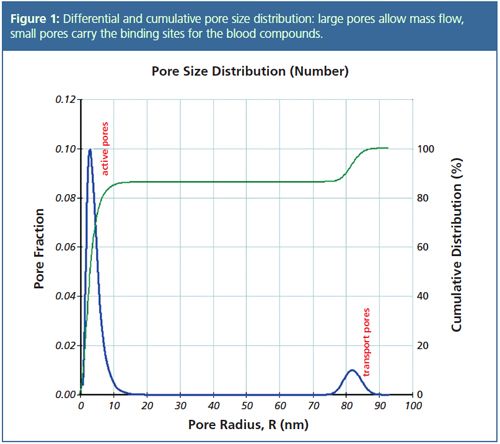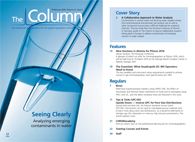Tips & Tricks GPC/SEC: Upside Down — Inverse GPC for Pore Size Distributions
Gel permeation/size-exclusion chromatography (GPC/SEC) is the standard method for separating samples by molecular size and determining molar mass distributions. However, GPC/SEC instruments can also be used to investigate porous materials and to learn more about pore size distributions, as a powerful alternative to nitrogen gas (N2) adsorption or mercury (Hg) intrusion porosimetry.
Daniela Held and Peter Kilz, PSS Polymer Standards Service GmbH, Mainz, Germany.
Gel permeation/size-exclusion chromatography (GPC/SEC) is the standard method for separating samples by molecular size and determining molar mass distributions. However, GPC/SEC instruments can also be used to investigate porous materials and to learn more about pore size distributions, as a powerful alternative to nitrogen gas (N2) adsorption or mercury (Hg) intrusion porosimetry.

Gel permeation/size-exclusion chromatography (GPC/SEC) separates samples based on the size of dissolved macromolecules using porous beads as the stationary phase and a good solvent as the mobile phase. The retention of the macromolecule depends mainly on the size of the pores and of the stationary phase beads amongst other parameters.
The most commonly used technique to visualize how a stationary phase separates is to plot the measured elution volume/time versus the logarithm of the molar mass of calibration standards/reference material covering a range of sizes/molar masses. These curves are referred to as calibration curves because they allow the molar mass distributions of unknowns to be determined.
In addition, they reflect the complete pore size distribution and can therefore be used to learn more about porous structures in their native state.
If calibration curves are evaluated in detail using the appropriate software a variety of parameters can be determined using standard chromatographic equipment.1,2,3
This technique is then called inverse GPC; for example, the pore size distribution can be calculated applying models for chains and pore structures. Detailed analysis of pore accessibility yields a multitude of analytical
results, which can be derived from the pore size distribution; the following results are accessible with this
technique:
- Average pore size
- Dispersity of pore sizes
- Pore size distribution
- Pore volume
- Specific surface area
- Optimum size of guest molecule
- Selectivity parameters.
How to Perform Inverse GPC
Basic GPC/SEC equipment can be used to perform the measurements. The main difference with traditional GPC/SEC is that the unknown sample, the porous material to be characterized, is not dissolved in the mobile phase and injected, but is instead packed into the chromatography column, which is then installed into the GPC/SEC system.
Several samples consisting of molecules of different and known molar masses are dissolved in the eluent and then injected onto the column via an automated or manual injection valve. The (isocratic) pump forces the samples to migrate through the packed chromatography column. A detector, most commonly a refractive index detector (RI), measures the elution volume. Typical for GPC/SEC, the large molar masses penetrate none or very few pores and elute first, while the smaller molecules, which can access more pores, will elute later. The resulting table, which relates the size or molar mass and the elution time, can then be used to calculate the desired results. This can be achieved by using software that already offers calculations with different models for pores.
Advantages of Inverse GPC
Inverse GPC is a cost-effective method that does not require highly toxic compounds. The porous materials are characterized in their native state (not in high vacuum or under high pressure) and only the accessible pores are investigated. Bottleneck pores or pores without external access are not screened.
The covered range of pore sizes is very wide spanning from 5 Å to over 6000 Å. Some typical applications are catalysts and catalyst supports, ion exchange resins, ceramics, nano materials, absorbents, high throughput screening carriers, drug delivery systems, or bio-reactors.
Packing Samples into the Column
While porous materials with larger diameters can be poured into the column using a funnel, smaller diameter samples should be slurry packed. The same is true if the particles swell considerably in the eluent; in that case, the porous material has to be swelled first and then transferred into the test column. In most cases the slurry can be gravity filled into the column.
The efficiency of the column packed with the porous material is not crucial because resolution is not important. Narrowly distributed probe molecules will be injected one at a time and only their retention volume (peak position) is required for subsequent data processing. Peak width and shape are not important.
If the mass of the porous material filled into the column is weighed out, additional result calculations are possible.
How Do the Results Look?
An example can best demonstrate what can be learned from inverse GPC. Blood treatment to remove undesired proteins, cholesterol, or polysaccharides has become vital for many patients. Modern pharmaceutical technology uses adsorber cartridges packed with a porous material, which selectively adsorbs the unwanted compound from the bloodstream.
It is important that the adsorber’s pore structure does not hinder the access of the compound to its binding site or interfere in any way. Adsorber quality depends on accessibility of binding sites, average pore size, pore size distribution, and pore volume (as a measure of capacity).

For characterization the adsorber was packed in a column and Pullulan standards were used to measure the elution volumes. Figure 1 shows the graphic results after analyzing the data properly. Here two different pore sizes can be identified. While the small pores carry the binding sites, the big pores allow access to those binding sites (transport pores). The cumulative distribution in Figure 1 shows the number–fraction of small and large pores.
The overall pore size is 14.8 nm, whereas 75% (by volume) have a pore size of 81.9 nm. These pores are all the same size. In contrast the small pores are only 4.3 nm wide. The high pore volume of this blood adsorber packing (53%) allows for a high adsorption capacity.
Another important parameter in this application is the optimal size of a guest molecule, which must bind to the receptor in the adsorber pore. This adsorber has pores that absorb molecules, with 1.5 nm the optimum size. The compound to be removed from the blood should not be substantially bigger or smaller than 1.5 nm to ensure optimal results.
Conclusions
Inverse GPC is a cost-effective alternative to characterize porous materials with pore sizes in the range 5Å to 6000Å.
Standard GPC/SEC equipment and procedures can be used. The major difference is that the sample is packed as the column stationary phase material.
Software tools allow the pore size distributions, specific surface areas, pore volumes and many other parameters to be determined just by analyzing typical GPC/SEC calibration curves.
The quality and consistency of GPC/SEC column materials can be controlled using inverse GPC.
References
- E.F. Casassa, Macromolecules9, 182 (1976).
- D.H. Freeman and I. C. Poinescu, Anal. Chem. 49(8), 1183–1188 (1977).
- A.A. Gorbunov, L.Y. Solovyova, and V.A. Pasechnik, J. Chromatogr.448, 307 (1988).
Daniela Held studied polymer chemistry in Mainz, Germany, and works in the PSS software and instrument department. She is also responsible for education and customer training.
Peter Kilz studied polymer chemistry in Mainz, Germany, and Liverpool, UK. He is one of the founders of PSS and head of the software and instrument department. He is also involved in customer support and training.
E-mail: DHeld@pss-polymer.com
Website: www.pss-polymer.com

Regulatory Deadlines and Supply Chain Challenges Take Center Stage in Nitrosamine Discussion
April 10th 2025During an LCGC International peer exchange, Aloka Srinivasan, Mayank Bhanti, and Amber Burch discussed the regulatory deadlines and supply chain challenges that come with nitrosamine analysis.










